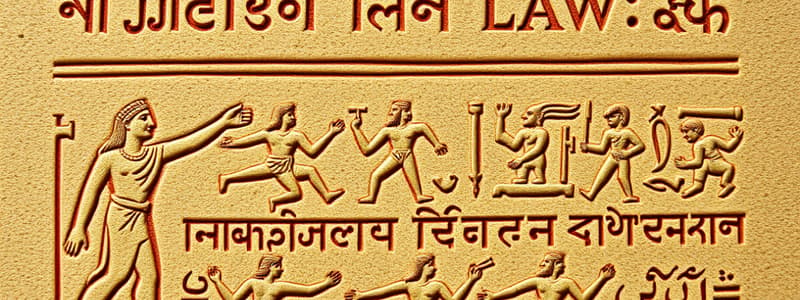Podcast
Questions and Answers
Which feature characterizes the Hittite language?
Which feature characterizes the Hittite language?
- It has no attested documents.
- It is written in Latin script.
- It is written in cuneiform script. (correct)
- It is one of the youngest Indo-European languages.
What was a significant aspect of Hittite law?
What was a significant aspect of Hittite law?
- Legal codes were not documented.
- Laws were solely punitive in nature.
- All individuals faced the same penalties.
- There was a focus on compensation for damages. (correct)
What military advantage did the Hittites possess?
What military advantage did the Hittites possess?
- An untrained infantry.
- Renowned use of chariots. (correct)
- Superior naval forces.
- Heavy reliance on cavalry.
Who was considered the chief deity in Hittite religion?
Who was considered the chief deity in Hittite religion?
What type of art was the Hittite civilization particularly known for?
What type of art was the Hittite civilization particularly known for?
In Hittite military strategy, what served as a significant defensive feature of their cities?
In Hittite military strategy, what served as a significant defensive feature of their cities?
How did the Hittites integrate their religious practices with those of other cultures?
How did the Hittites integrate their religious practices with those of other cultures?
What type of text was NOT typically found in Hittite documents?
What type of text was NOT typically found in Hittite documents?
Flashcards are hidden until you start studying
Study Notes
Hittite Language
- Indo-European Family: The Hittite language is one of the oldest attested Indo-European languages.
- Cuneiform Script: Written in cuneiform, adapted from Mesopotamian scripts.
- Documents: Includes legal, religious, and administrative texts, as well as treaties and literature.
- Sound Changes: Displays early sound changes indicative of Indo-European phonetic shifts.
Hittite Law
- Legal Codes: The Hittites had a complex legal system, codified in various documents.
- Focus on Compensation: Many laws focused on compensation for damages rather than punitive measures.
- Social Hierarchy: Laws reflected social stratification, with different penalties for nobles and commoners.
- Judicial Process: Trials often involved a panel of judges and sometimes the use of oaths or divine judgment.
Hittite Military
- Chariotry: The Hittite military was renowned for its use of chariots, which were integral to their warfare strategy.
- Infantry: Included archers and spearmen, supplemented by allied forces.
- Fortifications: Cities were heavily fortified, with walls designed for defense against invasions.
- Expansion: Military conquests expanded their territory into Anatolia, Syria, and beyond, establishing the Hittite Empire.
Hittite Religion
- Polytheism: The Hittites practiced polytheism, worshipping a pantheon of gods and goddesses.
- Rituals and Sacrifices: Religious ceremonies often involved sacrifices and rituals to appease deities.
- Storm God: The chief deity was the Storm God, reflecting the importance of weather in agriculture and warfare.
- Integration of Cultures: They incorporated elements from the religions of conquered peoples, leading to a syncretic belief system.
Hittite Art and Architecture
- Sculpture: Known for monumental sculptures, particularly reliefs depicting gods, animals, and historical scenes.
- Architecture: Utilized mudbrick and stone; notable structures include temples and palaces.
- Reliefs: Wall reliefs often depicted military victories, religious rituals, and royal imagery.
- Symbolism: Art often carried symbolic meaning, reflecting the power and beliefs of the Hittite state.
Hittite Language
- Hittite is among the oldest known Indo-European languages, providing insights into the linguistic evolution.
- Utilized cuneiform script for writing, adapted from earlier Mesopotamian writing systems.
- Document types include legal codes, religious texts, administrative records, treaties, and literature, highlighting a rich cultural output.
- Exhibits early Indo-European phonetic changes, indicating the language's historical evolution.
Hittite Law
- Hittite legal system was sophisticated, encapsulated in various codified documents that guided societal conduct.
- Emphasis on compensation for damages reflects a focus on restorative justice over punitive penalties.
- Legal codes showcased social hierarchy, imposing different penalties based on the status of individuals (nobles vs. commoners).
- Judicial processes involved panels of judges and sometimes included divine judgments or oaths to determine outcomes.
Hittite Military
- Renowned for their advanced chariotry, which played a crucial role in military engagements and strategies.
- Infantry comprised archers and spearmen, often supported by allied troops during conflicts.
- Cities were fortified significantly with defensive walls to protect against external threats and invasions.
- Military conquests expanded the Hittite Empire's territory across Anatolia, Syria, and adjacent regions.
Hittite Religion
- Practiced a polytheistic belief system, venerating a diverse pantheon of deities.
- Religious practices involved various rituals and sacrifices aimed at appeasing gods, integral to their culture.
- The Storm God, a central figure in Hittite worship, underscored the significance of weather patterns in agriculture and warfare.
- Hittite religion absorbed elements from the customs of conquered cultures, creating a syncretized belief system.
Hittite Art and Architecture
- Notable for monumental sculptures and reliefs which depicted deities, animals, and significant historical events.
- Employed both mudbrick and stone in construction; important architectural achievements include temples and palatial structures.
- Wall reliefs commonly illustrated military triumphs, religious ceremonies, and royal iconography.
- Artistic expressions carried symbolic meanings that reinforced the power dynamics and religious beliefs of Hittite society.
Studying That Suits You
Use AI to generate personalized quizzes and flashcards to suit your learning preferences.




